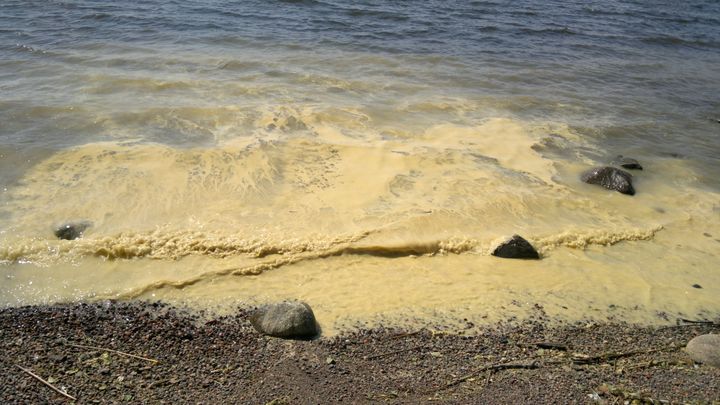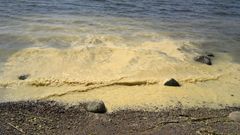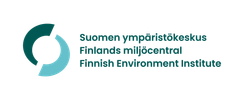CORRECTION: The blue-green algae situation calm both in the Baltic Sea and in lakes

Currently, variable, windy weather and cool water temperatures keep blue-green algae under control. The situation is typical for the time period. In early summer, abundant blue-green algae blooms rarely occur. The short warm period in May warmed the waters, and minor blue-green algae blooms occurred, in places, in lakes. At the moment, some blue-green algae are found in two lake observation sites of national blue-green algae monitoring, in Southern Finland. In the Baltic Sea, no blue-green algae blooms have been detected in satellite images.
In early summer, there may be plenty of coniferous pollen, which turns the water yellowish. Mass occurrence of pollen can be confused with blue-green algae blooms. Although blue-green algae blooms usually colour the water greenish or blueish green, yellowish blue-green algae blooms also occur. In some sea areas, pollen has also been visible in satellite images, this spring.
Blue-green algae blooms occur in waters with sufficient phosphorus nutrients. The surface blooms of blue-green algae are most common in calm weather. Wind will mix surface blooms with surface water, making it difficult to detect blue-green algae blooms. A strong or long-lasting wind, blowing from the same direction, can carry blue-green algae in the wind direction to the shores and bays. As warm water accelerates the growth of blue-green algae, blue-green algae blooms are most commonly found during the summer holidays in July-August, both in lakes and the Baltic Sea.
Observations of blue-green algae on map
SYKE observes the cyanobacteria occurrence as part of the monitoring of the state of the environment
The national cyanobacterial monitoring is carried out as part of the monitoring of the state of the environment in cooperation with the Centres for Economic Development, Transport and the Environment (ELY Centres), municipal environmental and health authorities and the Finnish Environment Institute (SYKE). Finnish Rotary Clubs are also actively involved in nationwide cyanobacterial monitoring.
The cyanobacterial monitoring is based on the monitoring of cyanobacterial deposits in surface water, and the intention is to provide an overview of the cyanobacterial situation in different water bodies. The monitoring includes about 400 permanent observation sites across the country on inland and coastal waters and in the archipelago.
Information on the cyanobacterial situation in the open sea areas is mainly obtained from satellite images, but also from the Finnish Border Guard, the marine research vessel Aranda, the optical device located at the Utö Atmospheric and Marine Research Station, as well as cruise and merchant ships (MS Finnmaid and MS Silja Serenade) equipped with Alg@line measuring equipment. The drift forecasts for cyanobacterial rafts in open sea areas are prepared in cooperation with the Finnish Meteorological Institute's Maritime Services.
SYKE reports on the national cyanobacterial situation on a weekly basis every Thursday from the beginning of June until the end of August. The weekly algal reporting on the national cyanobacterial monitoring was launched in 1998.
Several compounds produced by cyanobacteria can cause health hazards
According to the Finnish Institute for Health and Welfare (THL), cyanobacterial occurrences can cause health hazards. Cyanobacteria produce a number of different compounds that can cause symptoms. Some cyanobacteria can produce liver or nerve toxins, but most of the symptoms experienced by swimmers may also be due to other compounds.
Small children and pets should particularly be kept out of water rich with cyanobacteria. Water with cyanobacteria should not be used in a sauna or as washing or irrigation water. If you suspect a poisoning, seek medical advice, or take the pet to a veterinarian. If necessary, the Poison Information Centre will provide additional instructions.
The municipal health authorities monitor the cyanobacterial situation on beaches.
Read more about blue-green algae and health:
- At the the Finnish Institute for Health and Welfare (THL) website
- At the Poison Information Center website
Report your cyanobacterial observations to the Järvi-meriwiki (Lake and sea wiki)
In Järvi-meriwiki, maintained by the Finnish Environment Institute, you can establish your own observation site and share cyanobacterial observations or make individual observations when moving around waterways. You can also report observations via the smartphone-friendly Havaintolähetti website.
The reported observations are shown on the national cyanobacterial observation map, and they support the national algal situation assessment. Observations about the absence of cyanobacteria are also important.
Järvi-meriwiki is an online service produced in collaboration with authorities and citizens. The service provides basic information on all lakes larger than one hectare as well as different areas of the Baltic Sea. Users can share, for example, photos and other observations on the service.
Municipalities and cities monitor the cyanobacterial situation on the beaches, so it is advisable to report rich cyanobacterial occurrences on beaches to the health authorities of the municipality in question.
Cyanobacterial observations also in the Itämeri.fi and vesi.fi services
The cyanobacterial maps presented on the websites MarineFinland.fi and Vesi.fi combine the observations reported to the Järvi-meriwiki and from the beaches of the City of Helsinki, as well as the observations based on satellite interpretations made by Syke during the last three days.
• National algal review at Järvi-meriwiki
• Marinefinland.fi algae observations
This is how you identify cyanobacteria
A small amount of cyanobacteria in the water appears as green or yellowish particles. Narrow stripes of algae can drift to a beach. In calm weather, a substantial amount of cyanobacteria forms greenish or yellowish algal rafts and piles up in coastal water. In spring, yellowish pollen from coniferous trees may also be present in the water. Unlike cyanobacteria, pollen is found not only on the surface water but also, for example, on piers or yard furniture.
Cyanobacteria dissolve into tiny particles in the water if you touch the algal mass with a stick. If the algae become attached to the stick, they are something other than cyanobacteria. In a water vessel, cyanobacteria rise to the surface as tiny greenish particles within about an hour.
- Read more about How do you recognize blue-green algae?
Summer 2023 algae forecast:
Warm and calm weather conditions can lead to powerful blooms of blue-green algae in the Baltic Sea 2023-06-01
Satellite observations:
• TARKKA, satellite observation service
Inquiries:
(Telephone 1 pm to 3 pm)
Lakes: Tel +358 50 5734 347 or +358 295 251 326
State of the Baltic Sea: Tel +358 50 5693 297 or +358 295 251 314
Satellite observations: Tel 358 50 4707 576 or +358 295 251 329, e-mail: Eotuki@syke.fi
Numbers starting with +358 295: price determined by the caller's operator.
Keywords
Contacts
Communications Intern Tytti Juusti, Finnish Environment Institute, Tel. 0295 252 323, firstname.lastname@syke.fi
Communication specialist Eija Järvinen, Finnish Environment Institute, tel. +358 295 251 242, firstname.lastname@syke.fi
Media service at Finnish Environment Institute
The Finnish Environment Institute's Media Service provides information on our research, helps journalists find experts for interviews and provides photos for media use.
Our Communication experts will answer your inquiries on weekdays from 9 am to 4 pm.
Images

Links
About Suomen ympäristökeskus
It is time to move beyond solving environmental problems one by one, to systemic sustainability transformations. The Finnish Environment Institute (Syke) contributes to building a sustainable society through research, information and services. The Finnish Environment Institute is a research institute with 700 experts and researchers located in Helsinki, Oulu, Jyväskylä and Joensuu.
Subscribe to releases from Suomen ympäristökeskus
Subscribe to all the latest releases from Suomen ympäristökeskus by registering your e-mail address below. You can unsubscribe at any time.
Latest releases from Suomen ympäristökeskus
Saaristomeren luontoarvoja kartoitetaan tulevana kesänä6.5.2025 08:10:00 EEST | Tiedote
Saaristomerellä kartoitetaan kesällä 2025 vedenalaista kasvillisuutta ekologisesti merkittävien merialueiden tunnistamiseksi. Näin voidaan tukea luonnonsuojelun suunnittelua ja huomioida aiempaa paremmin merellisiä luontoarvoja esimerkiksi kaavoituksessa.
Viikkokatsaus 5.–9.5.202530.4.2025 10:56:16 EEST | Tiedote
Hei! Tässä tiedoksesi meillä Suomen ympäristökeskuksessa ensi viikolla ilmestyviä tiedotteita, uutisia, kampanjoita, blogeja ja uutiskirjeitä. Mukana myös tulevia tapahtumia ja webinaareja. Jakelemme viikkokatsauksen torstaisin STT:n kautta. Koosteet löytyvät myös STT-uutishuoneesta, josta voit tilata kaikki Suomen ympäristökeskuksen tiedotteet.
Viikkokatsaus 28.4.–2.5.202524.4.2025 12:40:26 EEST | Tiedote
Hei! Tässä tiedoksesi meillä Suomen ympäristökeskuksessa ensi viikolla ilmestyviä tiedotteita, uutisia, kampanjoita, blogeja ja uutiskirjeitä. Mukana myös tulevia tapahtumia ja webinaareja. Jakelemme viikkokatsauksen torstaisin STT:n kautta. Koosteet löytyvät myös STT-uutishuoneesta, josta voit tilata kaikki Suomen ympäristökeskuksen tiedotteet.
Viikkokatsaus 22.–25.4.202517.4.2025 13:31:13 EEST | Tiedote
Hei! Tässä tiedoksesi meillä Suomen ympäristökeskuksessa ensi viikolla ilmestyviä tiedotteita, uutisia, kampanjoita, blogeja ja uutiskirjeitä. Mukana myös tulevia tapahtumia ja webinaareja. Jakelemme viikkokatsauksen torstaisin STT:n kautta. Koosteet löytyvät myös STT-uutishuoneesta, josta voit tilata kaikki Suomen ympäristökeskuksen tiedotteet.
Purkumateriaali- ja rakennusjäteselvityksen laadintaan saatavilla uusia ohjeita sekä purkumateriaalilaskuri16.4.2025 09:47:54 EEST | Tiedote
Tammikuussa käyttöönotetun purkumateriaalin ja rakennusjätteen selvitystietojärjestelmän (Rapu) kehitys jatkuu aktiivisena. Tietojärjestelmän käyttöön on nyt julkaistu täyttöohje ja selvityksen laatimista tukeva pienten rakennusten arviointiin tarkoitettu purkumateriaalien arviointilaskuri.
In our pressroom you can read all our latest releases, find our press contacts, images, documents and other relevant information about us.
Visit our pressroom
